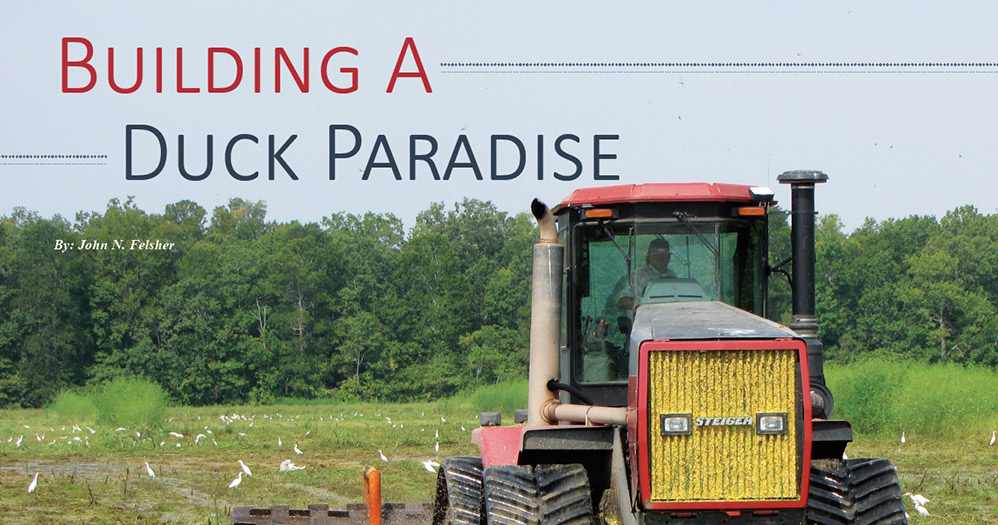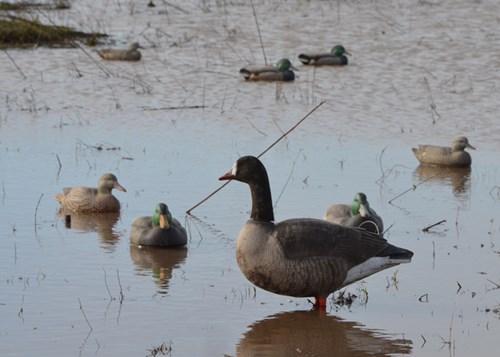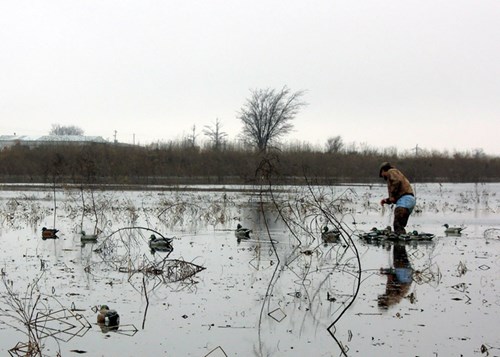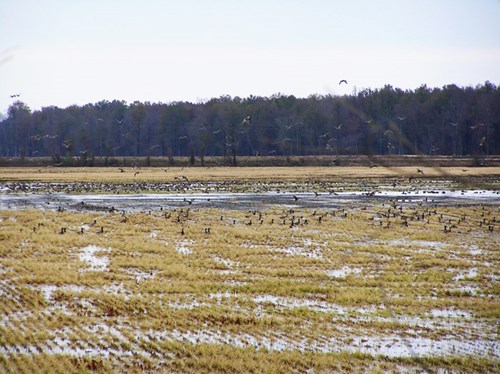Building a Duck Paradise
12/19/2017 1:25:54 PM
John N. Felsher

Waterfowlers can turn old croplands or catfish ponds into mallard havens with planning, investment, and hard work in a state with such a rich agricultural heritage as Mississippi.
“People could potentially create excellent waterfowl habitat from marginal agricultural property,” explained James Callicutt, a private lands biologist in the Ducks Unlimited (DU) Southern Regional Office in Jackson and a former waterfowl biologist for the Mississippi Department of Wildlife, Fisheries, and Parks (MDWFP). “Places that might not be productive for farmland can be ideal for turning into wetland habitat for waterfowl.”
Many landowners turn old croplands into “moist soil units,” marshy fields periodically flooded and dried. But waterfowlers can’t simply dig a hole in a field, spray it with a hose, and declare it a pintail paradise. They first need to do some research. For starters, look at the topography and the vegetation that grows on it, particularly plants that prefer wetter soils. Land managers can also search the internet for satellite or aerial photos of the property during different seasons. Imagery taken during a high water event can reveal where an area naturally floods.
“Before trying to turn a field into a duck hunting spot, consider the topography,” said Houston Havens, the MDWFP waterfowl program coordinator. “The first thing I would do is try to find an already existing low spot. The next thing I would look for would be some type of natural ridge that could serve as a levee to hold in water. People who try to take advantage of the existing terrain could save themselves a lot of money in the right spot.”
Of course, people who want to hunt waterfowl will need a nearby water source, such as a natural stream, reservoir, or canal. If no good water source is nearby, people can drill a well. Fortunately, on the banks of North America’s largest river with many tributaries flowing into it, Mississippi overflows, sometimes literally, with abundant water sources.

“In Mississippi, people can often just tap into an existing watershed with a lot of natural drainage flowing into it instead of creating a managed water source,” Havens suggested. “People need to look at the landscape to see where water will run off during a rain.”
After selecting a field, landowners should seek technical advice from MDWFP biologists or private conservation organizations such as Ducks Unlimited. Experts could visit the property, determine how water flows over it, and offer tips on how to best manage the land to create an ideal hunting spot. Frequently, technical advisors can also give landowners tips on getting financial help.
“Landowners can schedule a site visit for someone to come out on the property and give their thoughts on what should be done,” Callicutt advised. “Landowners can also get some cost-share assistance for building levees, installing water control structures, and other management projects. At DU, (we) are always looking for opportunities to help restore wetlands for waterfowl on public or private lands."
Several federal departments offer cost-share assistance and other conservation incentives for people who want to enhance or restore wildlife habitat. Some programs put critical habitat in easements so they will remain forever wild. Other programs even pay landowners to create or conserve wildlife habitat.
Landowners seeking technical and financial help might start with the local U.S. Department of Agriculture National Resource Conservation Service (NRCS; www.nrcs.usda.gov).
“The first thing a landowner can do to get help to improve wildlife habitat is to contact the local NRCS office,” said Ed Penny, the DU director of Public Policy for the Southern Region and former MDWFP Wildlife Bureau Director. “DU has some programs that can help landowners go through the process of restoring wildlife habitat. Landowners can also seek cost-share funding through several Farm Bill conservation programs.”
After obtaining all the technical and financial help necessary to begin, land managers need to develop a plan for what they must build or repair. The plan could include building levees or irrigation canals and adding pumps, water control structures, piping, wells, and other infrastructure to move water onto the property, hold it, and then drain the land.
Lucky landowners might find water retention and distribution systems already in place. In the past few years, numerous catfish farms, particularly in the duck-rich Mississippi Delta, went out of business because of rising fuel costs and intense foreign competition. A typical catfish farm consists of several shallow impoundments and associated infrastructure to move and manage water. Many aquaculture properties also include access roads and other assets.
“The unique characteristic about catfish ponds is they already have a complex of units that a developer can manage individually,” said Jacob Sartain, who develops hunting properties for Sartain’s Heritage in Madison. “That’s substantially easier than managing an entire swamp or slough.”

Some abandoned ponds have been idle for years. Grasses and aquatic plants sprouted on pond bottoms. Embankments grew thick with canes and brush that offer ducks cover from predators. Since these abandoned ponds sit on private land, few people probably ever hunted them. Birds migrating down the Mississippi River find nourishment and sanctuary in these impoundments.
To turn fish farms into hunting spots, land managers might need to replace or repair some of the existing infrastructures, clean out willows and other undesirable brush or other vegetation, and plant duck food. With some habitat manipulation and repairs, a landowner can turn an old fish farm quickly into an incredible waterfowl honey hole.
“In my opinion, managing out of production fish complexes is probably the easiest and most effective way to manage waterfowl,” Sartain advised. “It’s much easier to manage an old catfish farm and turn it into duck habitat than flooded timber or row crops. The pond bottoms are very fertile seed banks and grow up with moist soil grasses, sedges, millet, and other plants. To enhance that already existing habitat, we just manipulate the bottom and cultivate the right crops.”
During the spring or summer, land managers keep ponds and moist soil units dry to grow native vegetation or plant good waterfowl food crops to supplement what grows naturally. Local USDA representatives can be consulted about what to grow. Many waterfowlers plant millet, milo, rice, corn, or other grains. Growing a variety of crops gives birds food choices.
<p“On a newly constructed wetland project, I typically recommend that people plant Japanese or browntop millet to establish a food source for ducks going into the fall that first year,” Havens said. “In Mississippi, some quality natural waterfowl foods include grasses and sedges. They are natural annual seed-producing plants. One of the most common natural waterfowl foods in Mississippi is barnyard grass. Some people call it wild millet. Sprangletop is another good natural waterfowl food.”
As hunting season approaches, managers flood their lands. Dab-bling ducks such as mallards cannot feed in water much deeper than 18 inches. Most managers flood their fields or impoundments to about 6 to 12 inches deep. Some people vary the depth, leaving some areas with 3 to 4 inches of water for teal and digging holes for diving ducks to attract multiple species.
“If I had multiple impoundments, I’d flood some early to attract early migrants like teal,” Havens said. “If I just had one impoundment, I’d flood it about two to three weeks before duck season began. People can flood millet, natural grasses, and sedges a little earlier than something like a recently harvested soybean field. Agricultural seeds break down faster than natural seeds after flooding.”
Manipulating a planted crop and hunting waterfowl over it constitutes baiting, which is illegal. However, land managers can cut or disk native vegetation. Most people like to use 30 to 40 percent of the water surface area to create landing zones for ducks. If in doubt, consult the local authorities.
Most people start draining the water off the property in February or March but do not just open the gates to let out all the water at once. Many water control structures use boards to regulate water levels. Some landowner might remove one board at a time to lower the water level about six inches. About every two weeks, they pull another board.
“Part of the plan must include how to drain a property,” Havens explained. “People don’t want to impound water for the entire year. A slow drawdown helps hold seeds in the wetland and doesn’t flush them all out of the drain at once. As the water slowly drains, it keeps the soil moist so seeds can germinate.”
A good moist soil unit or old catfish pond can attract just about any duck that flies through Mississippi. Sportsmen might even bag some bonus snow or specklebelly geese. In a good spot, someone could create a waterfowling paradise that will continue attracting birds and making memories for many years.

John N. Felsher is a freelance writer for Mississippi Outdoors.









